Whom "Kondraty had"
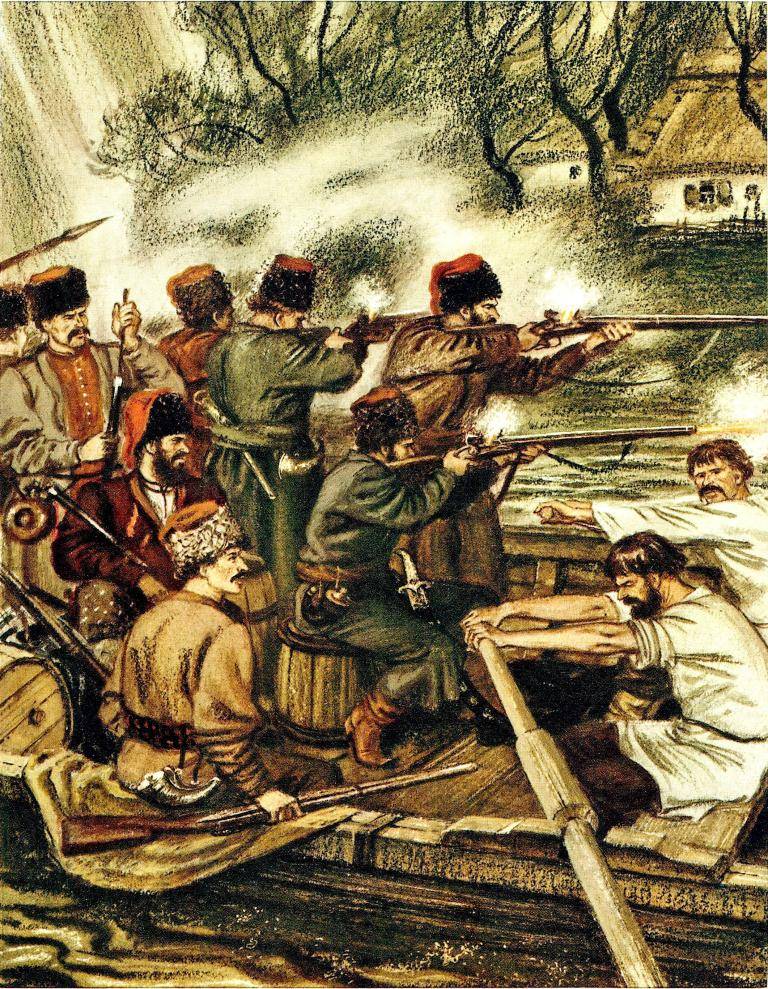
Article "The end of the Peasant War of Stepan Razin and the fate of the chieftains" we talked about the defeat of a grand rebellion under the leadership of this chieftain and the brutal repression that hit the inhabitants of the rebel regions. But how effective were these repressions, literally bleeding many cities and villages? Did they guarantee the stability of the tsarist regime, the loyalty of the Cossack Don and the quiet existence of landowners on the ground? And could the tsarist government, counting on the fear sowed among the people, continue the previous policy of widespread oppression and enslavement of its subjects?
The answer to this question is given by the uprising of the Don Cossacks led by Kondraty Bulavin, in which not "fathers" but "children" took part. The new leader of the rebels at the time of the execution of Razin was 11 years old. Representatives of the new generation knew very well about the cruelty of the Moscow authorities and remembered the numerous executions and tortures, but this did not in the least prevent them from rising again against the injustice of the new tsar - Peter I, the son of Alexei Mikhailovich.
Who is Kondraty Bulavin
It is believed that Kondraty Afanasevich Bulavin was born around 1660 in the town of Trekhizbyansky (now an urban-type settlement Trekhizbenka, Lugansk region). The version that Kondratius was born on the day of the execution of Razin is legendary and has a later origin.
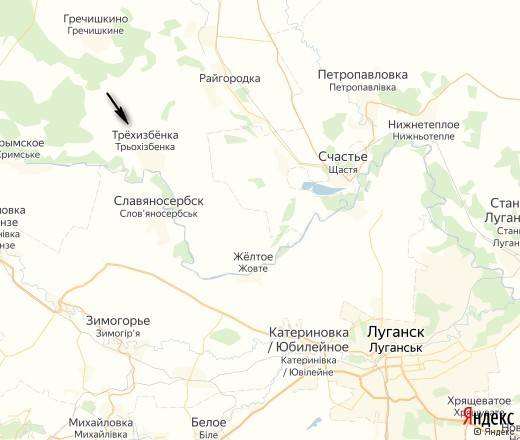
The village of Trekhizbenka on the map of Lugansk region
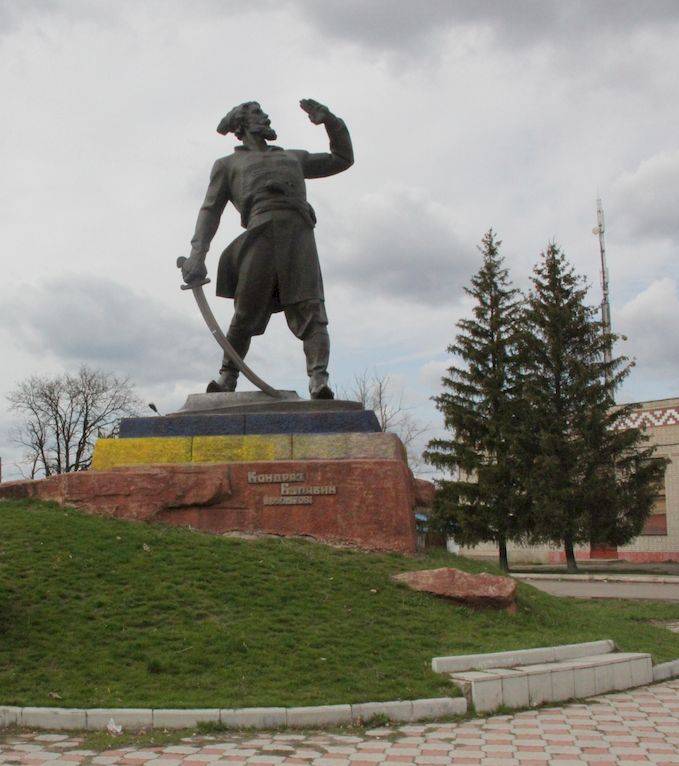
Monument to Kondraty Bulavin in the village of Trekhizbenka
But there is another version based on the testimony of Semyon Kulbaki, who stated during the investigation that “Bulavin is a Saltovets, from the Russian people”, that is, a native of Saltov’s town, “Kharkiv Sloboda Cossack Regiment”.
One way or another, Kondraty Bulavin really lived in the Trekhizbyansky town, he got married here (his first wife was Lyubov Provotorova, who gave birth to two children - a son and a daughter).
His father was a peasant who fled to the Don, probably from Liven district (the territory of the modern Oryol region) - information about this family is available in the documents of the Local and Bit orders. Athanasius participated in some of Stepan Razin’s campaigns, and later there was even a legend that he was the keeper of this chieftain’s mace, and “Bulavin” was not a surname, but a nickname. Over time, he became a village ataman, and during the tragic events of April 1670, he was probably on the side of the elders and the "dominant Cossacks" who captured Stepan Razin.
Thus, Kondraty Bulavin on the Don was a stately and completely respected man and faithfully served the Moscow authorities: as a field ataman he participated in wars against the Tatars, in 1689 went to the Crimean campaign of Prince Vasily Golitsyn, in 1696 - to the Second Azov campaign of Peter I. In 1704, Bulavin was placed at the head of the Cossack village in Bakhmut (a city in the modern Donetsk region, in Soviet times it was called Artyomovsky).
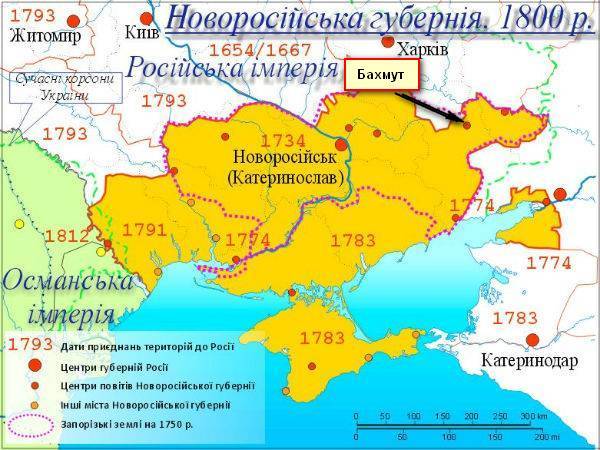
Bakhmut on the map of the Novorossiysk province, 1800
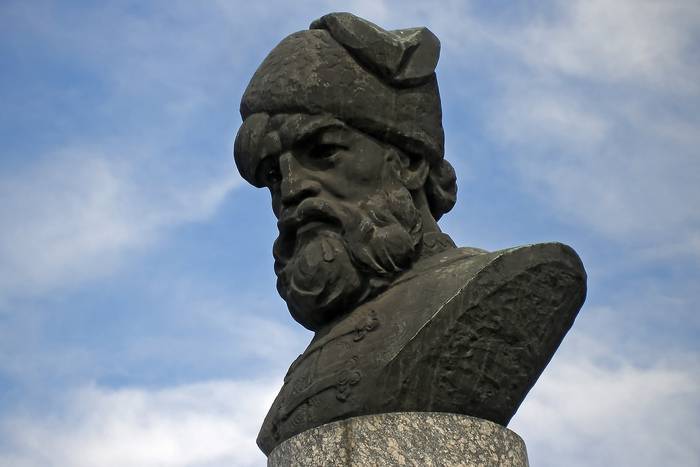
Kondraty Bulavin, a bust in the city of Bakhmut
Bakhmut was considered a Don village, however, suburban Cossacks, Cossacks, and a number of fugitive peasants from the central provinces of Russia also lived in it and in the surrounding villages. There were saltworks - a strategic enterprise, in those days: duty-free production and sale of salt was traditionally considered a privilege and one of the main sources of income of the Don Army.
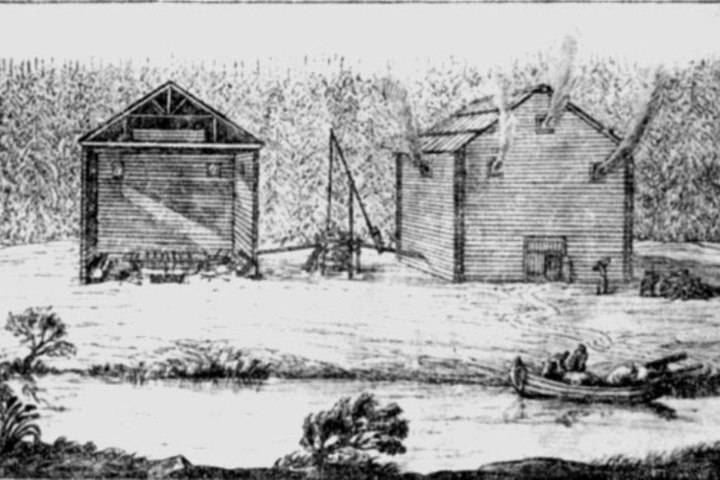
XNUMXth century Russian saltworks, drawing from Eric Palmquist's album
But in the country since 1700, there was a Northern War, and Peter I decided to replenish the state budget by introducing a state monopoly on the sale of salt, iron, wax, flax, bread, tobacco and some other goods. However, his omnipotent favorite, Alexander Menshikov, obtained a decree (dated October 13, 1704), according to which the proceeds from the Bakhmut saltworks were transferred to the Izyumsky Sloboda Cossack Regiment, commanded by the brigade leader Fyodor Shidlovsky, Danilych’s good acquaintance: “Those lands and lands in Bakhmut, Krasnaya and Stallion still own them, Izyumsky regiment foreman and the Cossacks. "
Evaluate the elegance of the combination: “justice is restored”, the income from saltworks is returned to the Cossacks, though not to the previous owners, but to the new ones — but the Cossacks are! Not Turks and Crimean Tatars. And Don Cossacks or Slobodskys - whoever is there, in Moscow or in St. Petersburg under construction, will understand.
Looking ahead, we say that such "business ties" of Shidlovsky were not brought to good. In 1711, he, in turn, decided to please the “Most Serene”: arbitrarily captured several villages that belonged to the Polish king, and ranked them among the adjacent estates of Menshikov. He violated the state border between Russia and the Commonwealth - no more, no less! ” He was arrested and deprived of all ranks and possessions. But, you understand: who would allow him, with such and such connections, to stay under arrest for a very long time? Szydlowski was released, the rank of Major General was returned, however, the estates that had ceded to the state were not returned: as they say, that has fallen, it has disappeared.
The beginning of the confrontation Kondraty Bulavin with the authorities
But back to a few years ago. Pursuant to the tsar’s decree, Szydlowski seized the Bakhmut saltworks, burned a village of indignant donors and at the same time robbed the local church - so as not to go twice. Then he raised the price of salt.
The recently appointed ataman of Bakhmut, Kondraty Bulavin, regarded such actions as a raider seizure and recaptured saltworks.
Szydlowski did not calm down and summoned the clerk Gorchakov to “describe the controversial Bakhmut lands." Bulavin arrested the clerk and sent him under guard to Voronezh. At the same time, he tried his best to look loyal to Moscow and tried to explain that he was not rebelling - in any case: restoring justice and hoping for an understanding of Moscow.
In 1707, Colonel Yuri Vladimirovich Dolgorukov was sent to the Don, who not only had to “genuinely search for the taxes and grievances that were previously repaired by the former Izyum regiment, Colonel and brigadier Fedor Shchidlovsky,” but also demand the extradition of all the fugitive peasants. And this already violated the old unwritten law, according to which "there is no extradition from the Don."
In 1674, the chieftain Semyon Buyanko called on the Don to "go to the Volga, to theft," and then rebels were called "thieves." The ataman wanted to "raise the Volga", to call the people "to the ax" - only three years after the execution of Stepan Razin! The Cossacks did not follow Buyanka, but when the Moscow authorities demanded that he be extradited, they answered:
And the government was forced to retreat: then no one wanted a new war on the Don.
But the Don Voivode Pyotr Ivanovich Bolshoi Khovansky wrote in the Ambassadorial order in 1675:
Please note: the prince who wants to make the Don Cossacks "slaves" considers himself a slave to the king, but sees nothing shameful in this.
At the beginning of the 1695th century, the situation did not change for the better for the Don people, and in Moscow they were ready to recognize only those who came to the Don from the “internal” regions of Russia before XNUMX as Cossacks.
However, the Cossack foremen took from the runaway payment for concealment, and the bribes received from them made up a considerable part of their income. And therefore, the stolniki Pushkin and Kologrivov, sent in 1703 to the Don for the census of the fugitives, did not achieve much success.
Trying to curry favor, Dolgorukov acted in the most cruel way. His methods are preserved in the description of Bulavin (which neither contemporaries nor historians questioned):
Well, truly, make ... "alternatively gifted" God pray - he will break his forehead. And, well, only myself. High-ranking corrupt officials, grabbers, blockheads, and Derzhimords diligently and purposefully pushed Don Cossacks, quite loyal to Moscow, to rebellion.
After all, Kondraty Bulavin was a man of a completely different warehouse than Razin. "Stenka" is the super-passionate leader of the "rebellious age", subordinating to his will and his charm all who were close to him. Standing in front of him, people felt an irresistible desire to kneel down, but Bulavin was just "the first among equals."
Razin in other circumstances could become the new Ermak, or he could become the second frantic archpriest Avvakum. In other countries and at another time, he would have a chance to repeat the exploits of Hillow Pedestrian, who “squeezed” Upper Normandy, Brittany, Caen and Er, the hero of the Reconquista Sid Campeador, Hernan Cortes, Jan ижižka, and even Napoleon Bonaparte. Bulavin appeared in the role of leader of a new rebellion quite by accident, leading a protest against apparent injustice. After the outbreak of active hostilities, when Prince Yu. Dolgoruky and the military chieftain Lukyan Maximov were killed and Bulavin occupied Cherkassk and was elected the new military chieftain there, he tried to enter into negotiations with Moscow, asking only for a return to the old order. Having not received an answer, he proclaimed the goals of the "liberation war": "To destroy those who do the untruths and live by a unanimous Cossack fraternity" (it was assumed that there are "kind" bosses and boyars, and even Tsar Peter, having figured it out, "did not order to ruin the Don towns and kill the Cossacks "). A folk song has been preserved, which emphasizes the "social" nature of his performance:
I didn’t rob on a dark night,
And with my own I am here
All walked on the steppes, but walked,
Yes, he smashed the boyars, the king’s governor.
And for this, here are honest people
I will only say thank you.
That is, not the robber ataman Kondraty Bulavin, but the intercessor of the people.
Another song talks about the courage and daring of this hero:
By chance, our Bulavin appeared,
Bulavin is not a simpleton, he is a dashing Don Cossack,
A brave warrior and Donetsk, he is a father for all.
He went to Turchin, beat a lot of unbelievers.
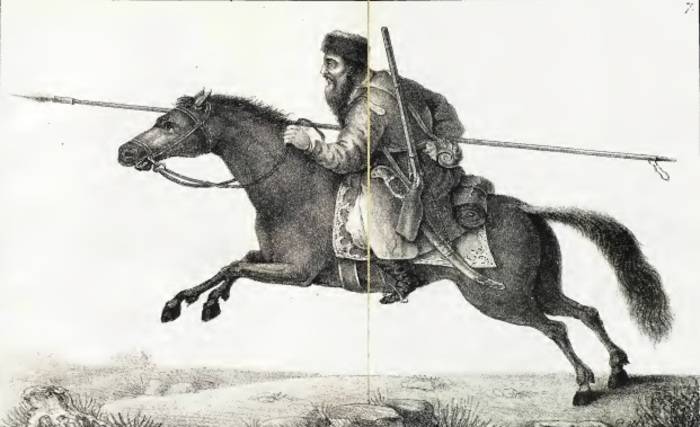
"Horse Don Cossack." Figure by Alexander Rigelman from the book "History or the story of the Don Cossacks "
Ignat Nekrasov and Semyon Drany were no less passionate than Bulavin, but Kondraty was more educated, smarter and “more flexible”, and therefore it was he who went down in history as the famous “thieves’ Don Ataman ”, becoming, in some way, the heir to Stepan Razin. S. M. Solovyov even called him “the new Razin,” G. V. Plekhanov “the titan of the people's revolutionary struggle.” And historians will talk about the Bulavin uprising, as about the "Third Peasant War."
1707 Autumn Campaign
But back to Yuri Dolgorukov: the self-confident prince then divided his detachment into four groups. The first operated from Cherkassk to Panshin, the second - according to Khopr, the third - according to Buzuluk and Medveditsa. For himself, Dolgorukov chose the area of the Seversky Donets. In total, 3000 escaped peasants were “found” (about the same number managed to escape), and many “old-time Cossacks” were declared as such. This is already, as they say, "did not climb into any gate" and angered everyone to the extreme. That's when Kondraty "grabbed" Yuri Dolgorukov.
At the beginning of October 1707, the chieftain of the Bakhmutsky town Bulavin gathered Cossack elders in Orekhovy Bueraka on the “Troop Council Common to All Rivers”, which decided to engage in battle with the punitive of Prince Dolgorukov.
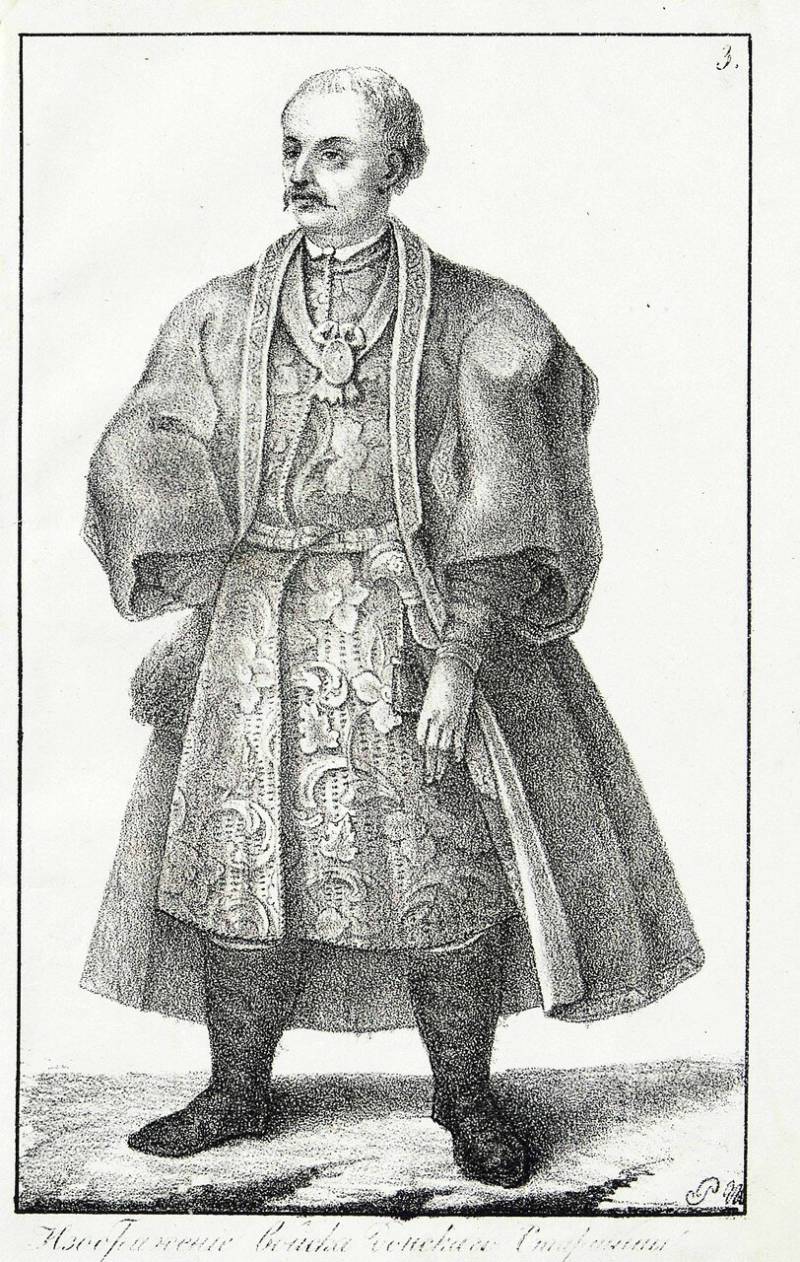
"Don Cossack Troops". Drawing from the book of A. I. Rigelman “History or narration of the Don Cossacks”
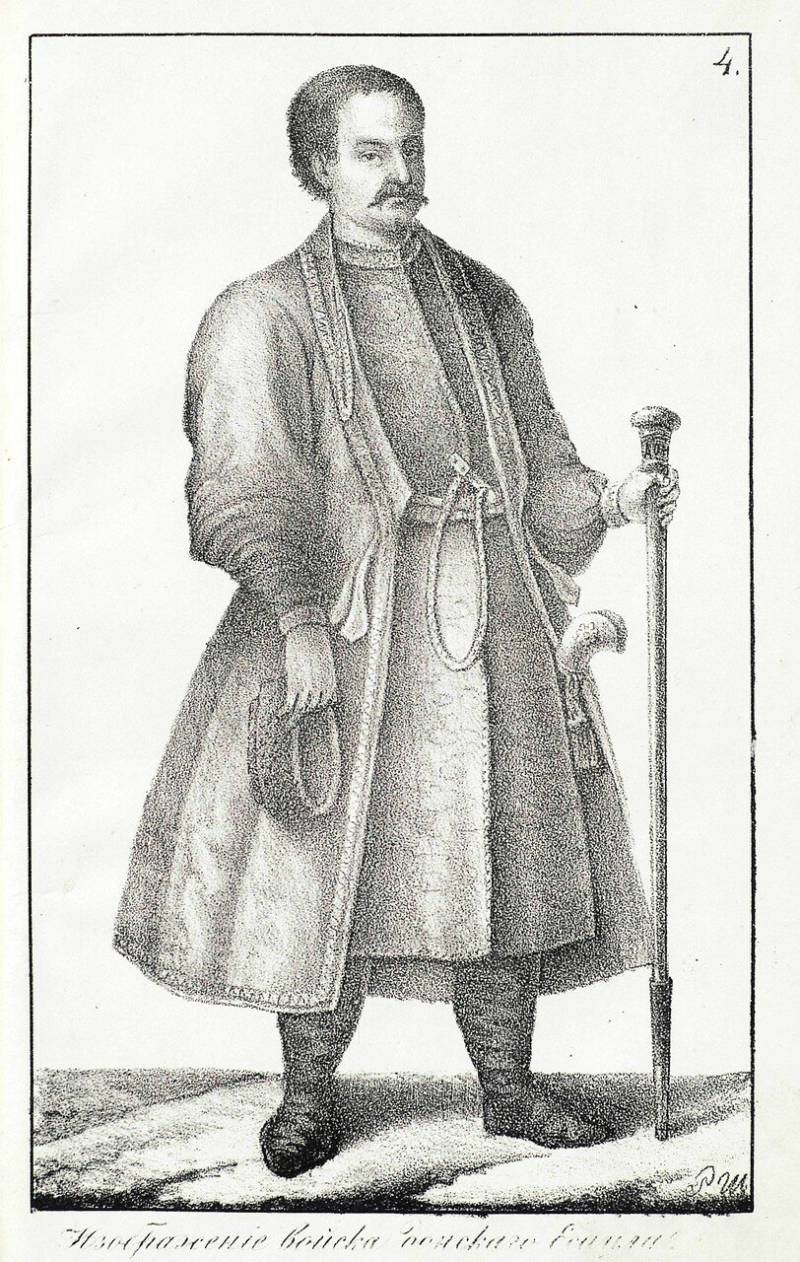
"Troops of the Don Esaul." Drawing from the book of A. I. Rigelman “History or narration of the Don Cossacks”
Late in the evening of October 9, 1707, in the town of Shulgin (currently the village of Shulginka, Starobelsky district, Lugansk region), the dragoons and Cossacks Dolgorukov were cut out during a sudden dashing attack, the head of the prince was personally cut down by Bulavin:
By chance, our Bulavin appeared.
Now do you understand what events the folk song quoted above alludes to?
According to another version, Kondraty “grabbed” the prince and his subordinates during the crossing of the Aidar River.
So there was a famous phraseologism, which is now more often pronounced as "konfrashka enough."
Other tsarist groups that copied the "runaway servants" along the Don, Khopr, Medveditsa and Buzuluk were almost completely destroyed.
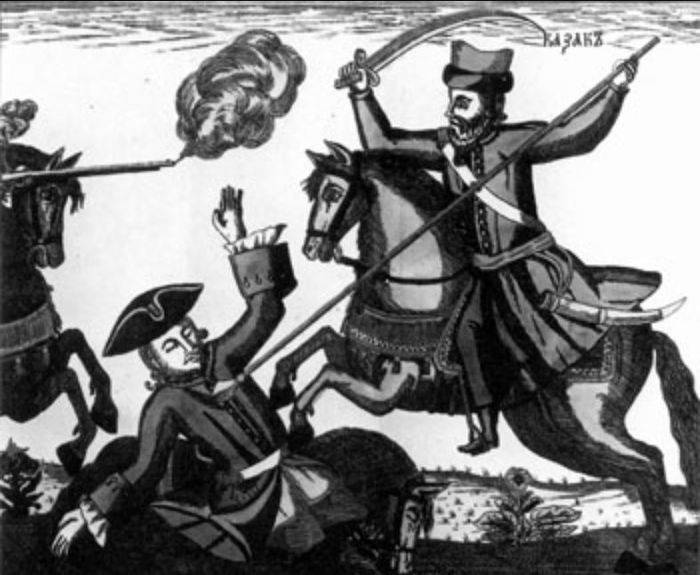
Don Cossack in battle with a soldier of the army of Peter I, lubok of the XVIII century
Troopers I. Kvasha, V. Ivanov, F. Safonov, village chieftains F. Dmitriev and P. Nikiforov were killed for helping punitive troops.
However, Cherkassk, Zakotny town, Osinova Luka, Old Aydar, Kobansky town and Krasnyanskaya village did not support this speech. A small circle of Cossack foremen in Cherkassk instructed army chieftain Lukyan Maximov to "bribe" the Bulavins - in order to avoid the invasion of new regular units of the Russian troops on the Don. Kalmyk prince Batyr also took part in the campaign against the rebels.
On October 18, 1707, Bulavin was defeated on the Aidar River near the Zakotnensky town, ten esaul and centurions were hanged on the trees by the legs, 130 Cossacks were “cut their noses”, many were sent “to other Ukrainian cities”.
Then a report was sent to Moscow that "the theft of Kondrat Bulavin was eradicated and it is safe to be quiet in all Cossack towns."
In response, the government sent 10 rubles to Don foremen, and 000 to Prince Batyr.
But Kondraty Bulavin was not killed and was not captured. At the end of November 1707, with 13 Cossacks loyal to him, he reached the Zaporizhzhya Sich. On December 20, on his initiative, a Rada was convened, at which Bulavin asked the Sachevs to join "the outrage of the riot in Great Russian cities." At the same time, the ataman Taras Finenko read out the imperial letter in which Peter I demanded that the “Don rebel” be issued.
The Zaporozhian Cossacks answered the tsar that in their army "it never happened, so that such people, rebels or robbers were given out." And what other answer could be expected from robbers and pirates?
But the ataman of the Cossacks at that time were interested in good relations with the Russian authorities, and Finenko persuaded everyone to postpone the decision to help Don until spring - "when the roads dry out."
Bulavin and his supporters did not wait for spring, and in February 1708 they organized a new parliament, which Foshenko “fired,” but nevertheless did not dare to enter into a confrontation with Russia, limiting herself to permission to go to the Don to the Cossacks, who themselves wish it .
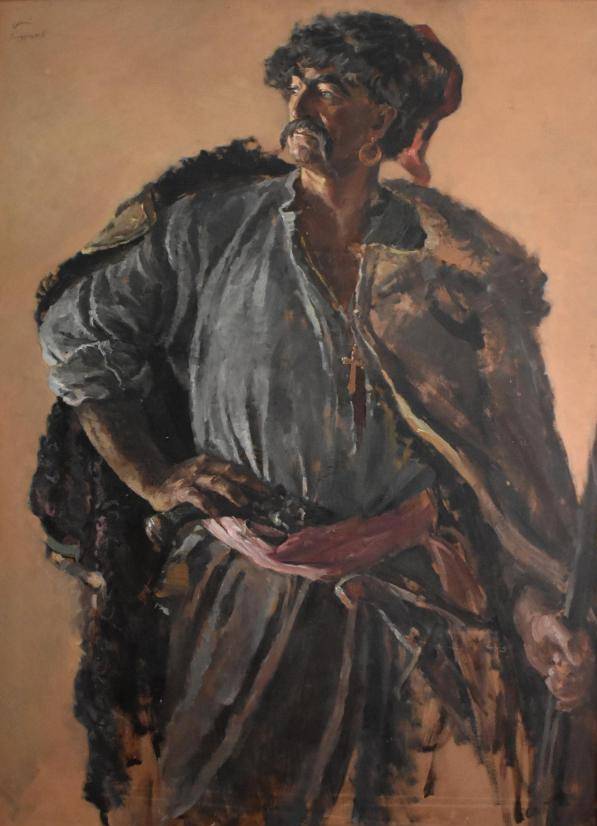
N. Ovechkin. “Cossack with an earring in his left ear”, sketch for the panorama “Rise of the Cossack poor in the Sich”
Return to Don
In March 1708, Kondraty Bulavin organized a new Cossack Circle in the Pristan Town on Khopre. Among others, Colonels Leonty Khokhlach, Ignat Nekrasov, Nikita Goly and the chieftain of the Old Aidarsky town Semyon Drany came to him - it was his opponents who were most afraid of all others. It was decided to go to Cherkassk to kill the “ugly foremen” who “sold the river”.
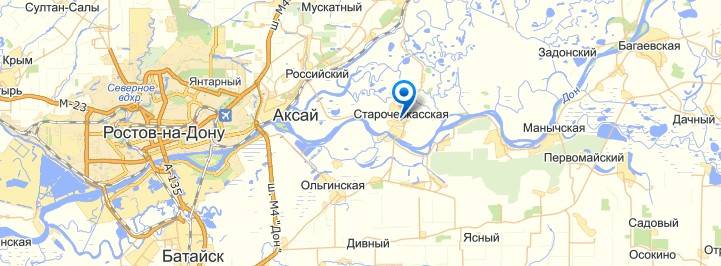
The village of Starocherkasskaya (formerly Cherkassk) on a map of the Rostov Region
Already on April 8, Semyon Drany without a fight captured Lugansk town. And the army chieftain Lukyan Maximov, meanwhile, gathered a detachment of grassroots Cossacks, to which the Kalmyks joined, and, joining the detachment of the Azov colonel Vasiliev, went towards the rebels - to the Liskovatka river. Here, on April 9, 1708, a battle took place near the city of Panshin, during which many Cossacks of Maximov sided with Bulavin. The rest fled, leaving 4 guns, a convoy and a military treasury in the amount of 8 thousand rubles.
On April 26, 1708, Bulavin approached Cherkassk. It was a fairly strong fortress, located on an island formed by the Don River, Protoka and Tankin Yerik, and on the fourth side a moat was dug. On its walls were more than 40 guns.
However, the chieftains of five of the six villages of Cherkasy Island took the side of the rebels, the city was surrendered. On May 6, it was decided to execute ataman Maximov and four foremen on the Army Circle, their supporters were "put in the water" (Ludwig Fabricius describes this execution as follows: "they tied a shirt over his head, poured sand there and threw it into the water").
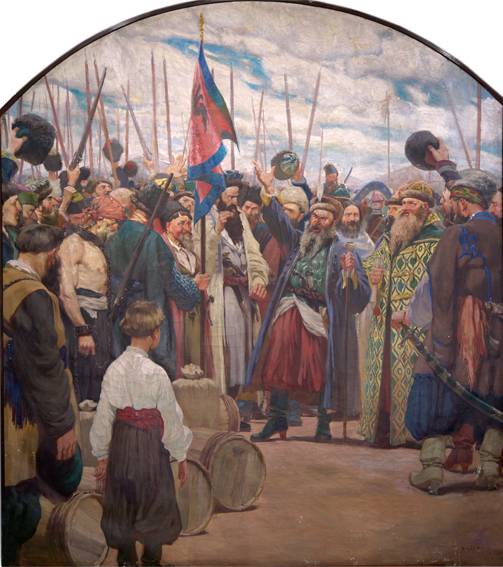
N. Ovechkin, “Volnitsa”. Museum of the History of the Don Cossacks
The new military chieftain was elected Kondraty Bulavin. One of his first orders was orders to confiscate the church treasury and reduce the price of bread.
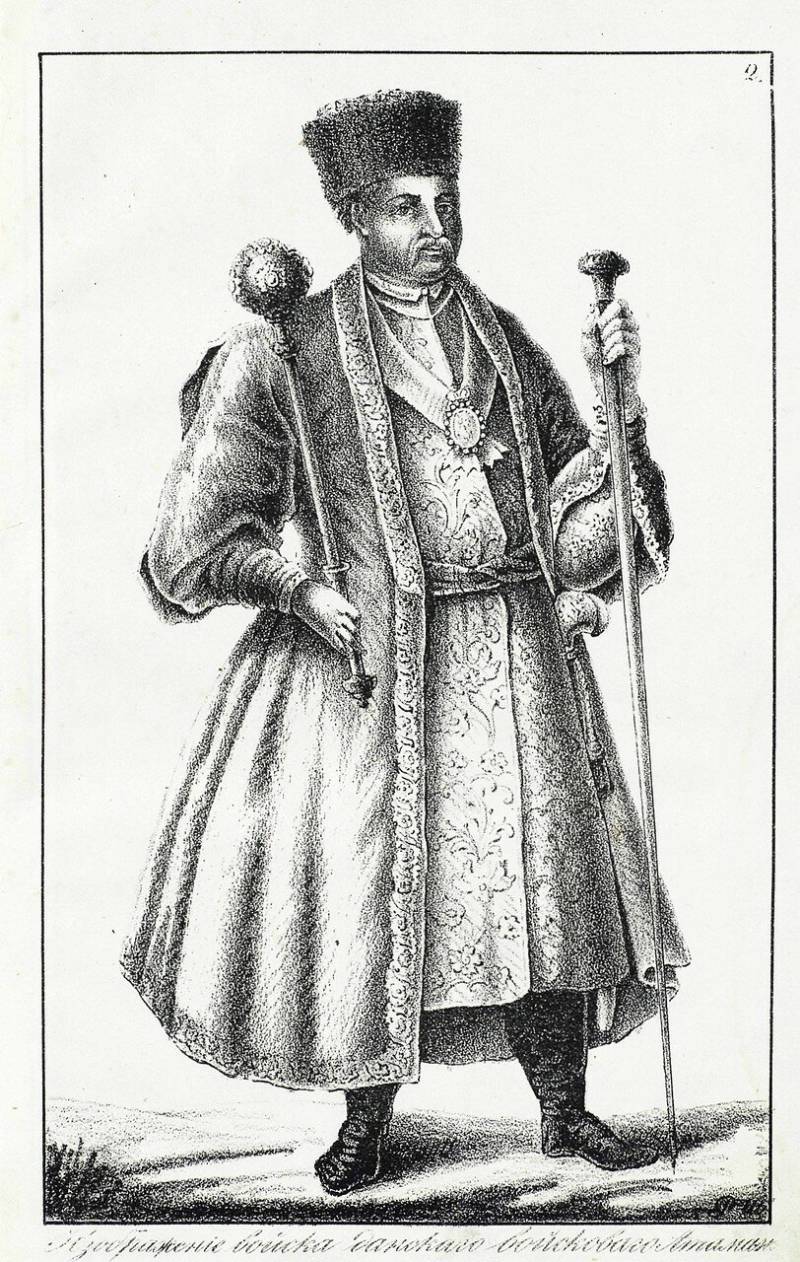
Ataman of the Don Cossacks. Drawing from the book of A. I. Rigelman “History or narration of the Don Cossacks”
Bulavin also tried to enter into negotiations with Moscow, asking that "everything was as it was before." If the authorities had entered into negotiations with him, it would probably have ended there: the new military chieftain would have led the Cossacks against the Tatars and Turks, sent the "villages" to the Ambassadorial order, asked for more lead and gunpowder to be sent to the Don, wrote letters of demand issuing runaway - everything is as usual. But the greed and stupidity of government officials, it was decided to correct the brutality of the military. The authorities responded to Don’s letter with the formation of an invasion army, led by the younger brother of Yuri Dolgorukov, Vasily, who was killed by Bulavin. The order given personally to Dolgorukov by Peter I on April 12, 1708 read:
And without this order on the Don, it was clear to everyone what methods this prince would act. Therefore, already at the end of May 1708, Bulavin, in fear of the death penalty, was talking about bringing the confessor to Peter I.
Sometimes you have to read that Bulavin was an "accomplice" of the hetman Mazepa, who had long conceived a betrayal. Even Pushkin writes about this in the poem Poltava:
His sent servants:
There are Cossack circles in the Don
They muddied with Bulavin.
However, we remember that the Zaporozhye chieftains refused the war with Moscow, but Mazepa was still completely devoted to Peter I, moreover, he then allocated two Cossack regiments to help Dolgoruky.
Mazepa's betrayal was described in an article The Russian Campaign of Charles XII, we recall that the hetman made the final decision on switching to the side of the Swedish king only in October 1708, learning about the movement of his army to Ukraine, this decision was not very easy for him, and he regretted it long before Poltava.
Preparing for war, Bulavin, like many of his predecessors, sent out “lovely letters” in which he wrote:
Donskoy Army Region at the beginning of the XNUMXth century
The situation of the rebels was unenviable. Even under Tsar Boris Godunov, the construction of fortresses began, covering the lands of the Don Army on all sides. Gradually, from Voronezh to Astrakhan, a system of fortified cities appeared, dividing the territory of the Don Army and the Yaitsky (Ural) Army. And the fortresses built from Bryansk and Belgorod to the upper river Medveditsa made it possible to control the communication of the Don with the Zaporizhzhya Sich.
The last link in this chain appeared in 1696 - it became the Russian fortress of Azov, for which the Cossacks themselves fought with the Ottomans for 15 years (from 1637 to 1641). Its significance was so high that in 1702 it was forbidden for Cossacks to fish from this fortress to the mouth of the North Donets, as well as "on the Sea of Azov and on the rivers beyond the river." The possible consequences of the thoughtless implementation of this decree were clear even to government officials who quietly worked on it: the severity and cruelty of Russian laws was once again compensated by the non-bindingness of their implementation.
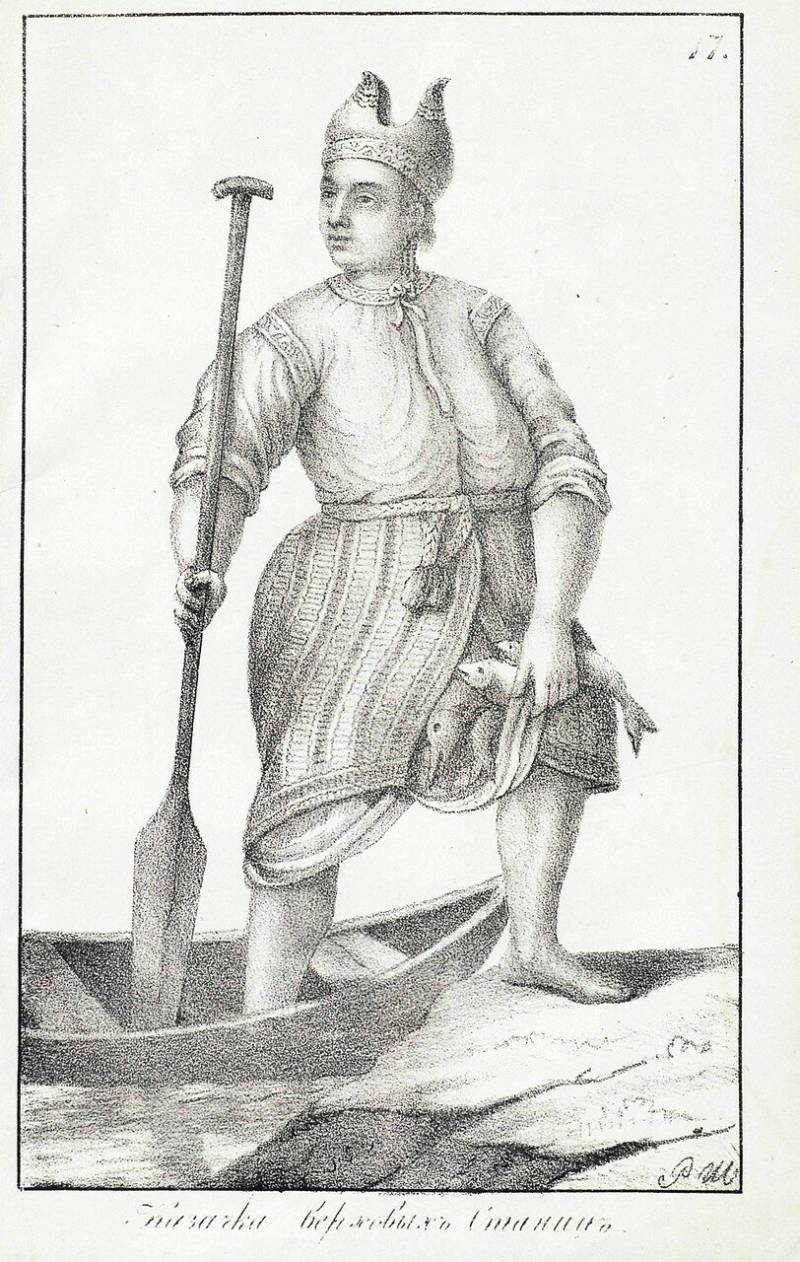
"Cossack coastal villages." Drawing from Rigelman’s book “The History or Narrative of the Don Cossacks”
In February 1706, another royal decree was issued: the Cossacks were forbidden to occupy the “empty” lands in the upper reaches of the Don: state peasants began to settle here. Also, landowners who brought their serfs began to rent plots of this land.
Now in the north of the region of the Don Army there were Russian troops of the stolnik I. Telyashov and Lt. Col. V. Rykman. In the east, near the Volga, stood the corps of Prince P.I. Khovansky (Lesser), who had just crushed the Bashkir uprising. The Kalmyk detachment of Khan Ayuki joined his troops. The mouth of the Don was locked by the Azov fortress with a strong garrison commanded by I.A. Tolstoy - the brother-in-law of Tsar Fedor Alekseevich (elder brother of Peter I), great-great-great-grandfather of F.I. Tyutchev. From the west was approaching the twenty-thousandth army of Vasily Vladimirovich Dolgorukov.
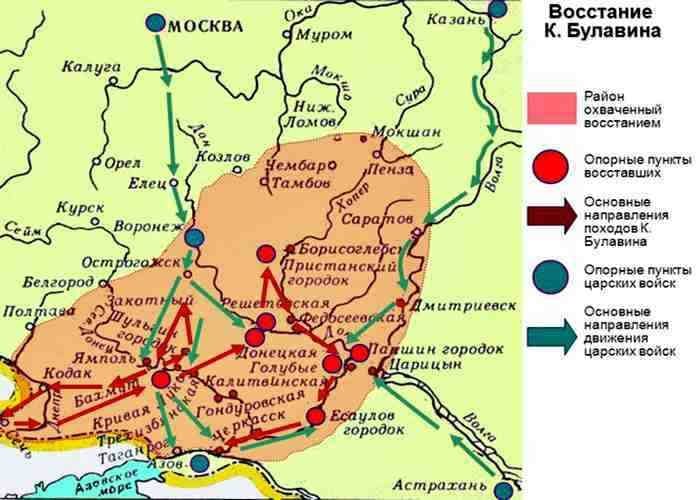
On the way to the army of Dolgoruky, 400 dragoons from Voronezh and the suburban Cossacks of the Akhtyrsky and Sumy regiments joined, led by the familiar Izyum colonel Shidlovsky. Thus, by the time the hostilities began, the total number of Dolgorukov’s troops alone reached 30-32 thousand people. The army of rebels was 20 thousand.
In the next article, we will talk about the battles of government troops with the armies of the rebels, the death of Kondraty Bulavin and his chieftains, as well as the fate of the Cossacks who left with Ignat Nekrasov in the Kuban.
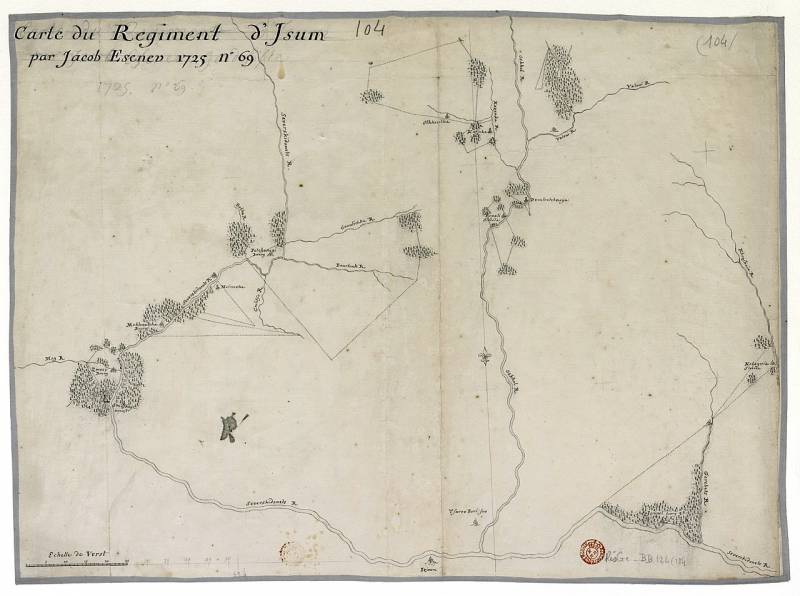
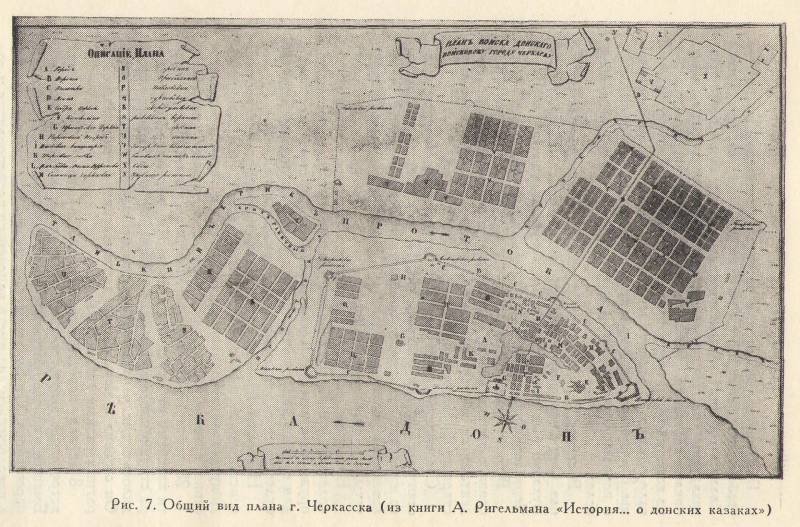
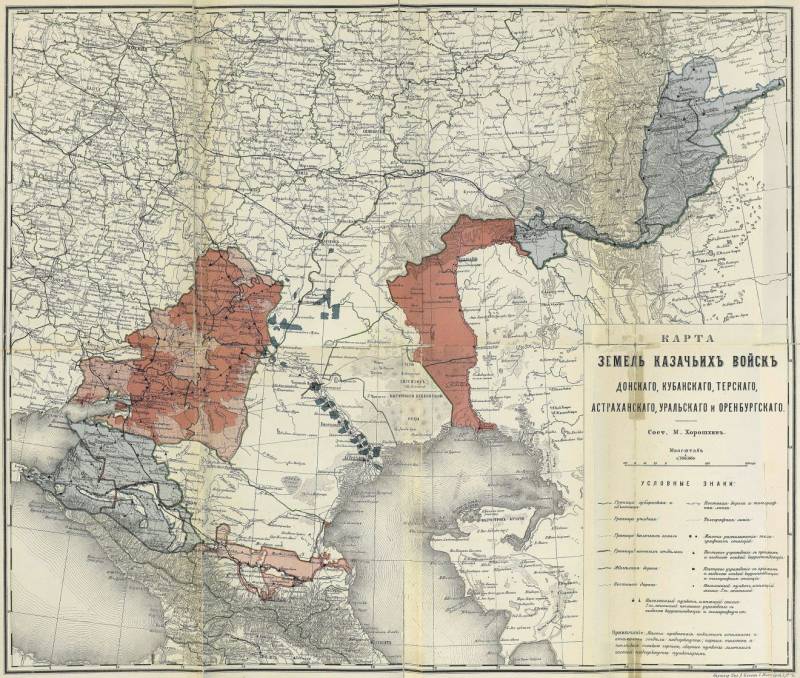
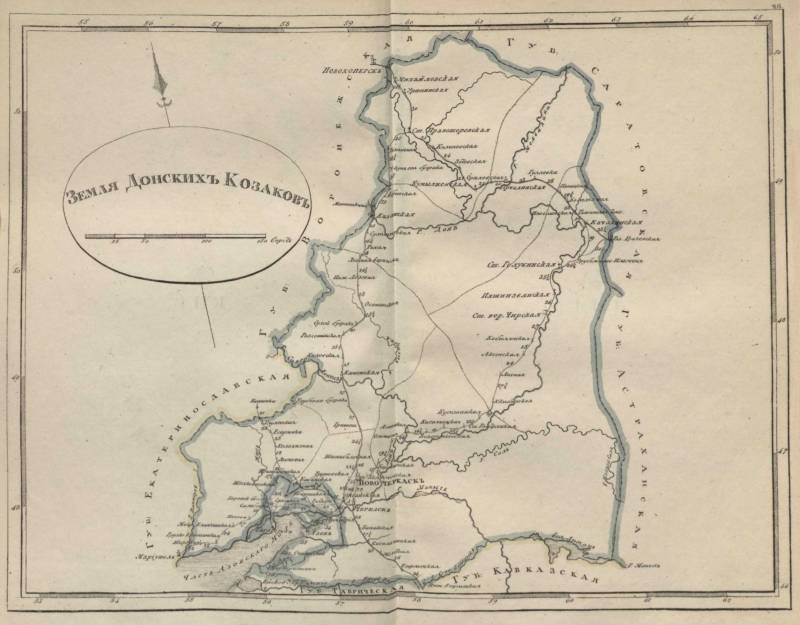
Information